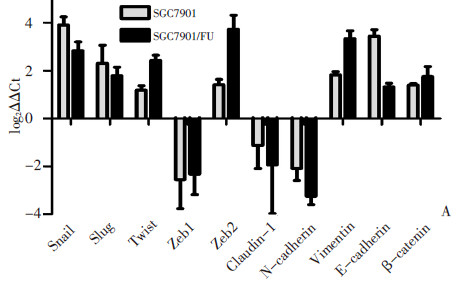|
[1]
|
Yang AD, Fan F, Camp ER, et al. Chronic oxaliplatin resistance in duces epithelial-to-mesenchymal transition in colorectal cancer cell lines[J]. Clin Cancer Res, 2006, 12(14 Pt 1): 4147-4153.
|
|
[2]
|
徐志远, 戴朝六, 王宁. 塞来昔布对人肝癌细胞株增殖及凋亡的影响[J]. 肿瘤学杂志, 2008, 14(11): 902-905. https://www.cnki.com.cn/Article/CJFDTOTAL-XHON200811012.htm
|
|
[3]
|
Xu ZY, Ding SM, Zhou L, et al. FOXC1 contributes to microvascular invasion in primary hepatocellular carcinoma via regulating epitheli al-mesenchymal transition[J]. Int J Biol Sci, 2012, 8(8): 1130-1141. doi: 10.7150/ijbs.4769
|
|
[4]
|
Taube JH, Herschkowitz JI, Komurov K, et al. Coreepitheli al-to-mesenchymal transition interactome gene-expression signature is associated with claudin-low and metaplastic breast cancer subtypes [J]. Proc Natl Acad Sci U S A, 2010, 107(35): 15449-15454. doi: 10.1073/pnas.1004900107
|
|
[5]
|
Yang J, Weinberg RA. Epithelial-mesenchymal transition: at the crossroads of development and tumor metastasis[J]. Dev Cell, 2008, 14 (6): 818- 829. doi: 10.1016/j.devcel.2008.05.009
|
|
[6]
|
Latifi A, Abubaker K, Castrechini N, et al. Cisplatin treatment of primary and metastatic epithelial ovarian carcinomas generates re sidual cells with mesenchymal stem cell-like profile[J]. J Cell Bio chem, 2011, 112(10): 2850-2864.
|
|
[7]
|
Basu D, Nguyen TT, Montone KT, et al. Evidence for mesenchy mal-like sub-populations within squamous cell carcinomas possess ing chemoresistance and phenotypic plasticity[J]. Oncogene, 2010, 29(29): 4170-4182. doi: 10.1038/onc.2010.170
|
|
[8]
|
Maseki S, Ijichi K, Tanaka H, et al. Acquisition of EMT pheno type in the gefitinib-resistant cells of a head and neck squamous cell carcinoma cell line through Akt/GSK-3 β/snail signaling path way[J]. Br J Cancer, 2012, 106(6): 1196-1204. doi: 10.1038/bjc.2012.24
|
|
[9]
|
Uchibori K, Kasamatsu A, Sunaga M, et al. Establishment and char acterization of two 5-fluorouracil-resistant hepatocellular carcino ma cell lines[J]. Int J Oncol, 2012, 40(4): 1005-1010. doi: 10.3892/ijo.2011.1300
|
|
[10]
|
Zhang W, Feng M, Zheng G, et al. Chemoresistance to 5-fluoroura cil induces epithelial-mesenchymal transition via up-regulation of Snail in MCF-7 human breast cancer cells[J]. Biochem Biophys Res Commun, 2012, 417(2): 679-685. doi: 10.1016/j.bbrc.2011.11.142
|
|
[11]
|
Marchini S, Fruscio R, Clivio L, et al. Resistance to platinum-based chemotherapy is associated with epithelial to mesenchymal transition in epithelial ovarian cancer[J]. Eur J Cancer, 2013, 49(2): 520-530. doi: 10.1016/j.ejca.2012.06.026
|
|
[12]
|
Scheel C, Weinberg RA. Cancer stem cells and epithelial-mesenchy mal transition: concepts and molecular links[J]. Semin Cancer Biol, 2012, 22(5-6): 396-403. doi: 10.1016/j.semcancer.2012.04.001
|
|
[13]
|
Hegde GV, de la Cruz C, Eastham-Anderson J, et al. Residual tu mor cells that drive disease relapse after chemotherapy do not have enhanced tumor initiating capacity[J]. PLoS One, 2012, 7(10): e45647. doi: 10.1371/journal.pone.0045647
|




 下载:
下载:




